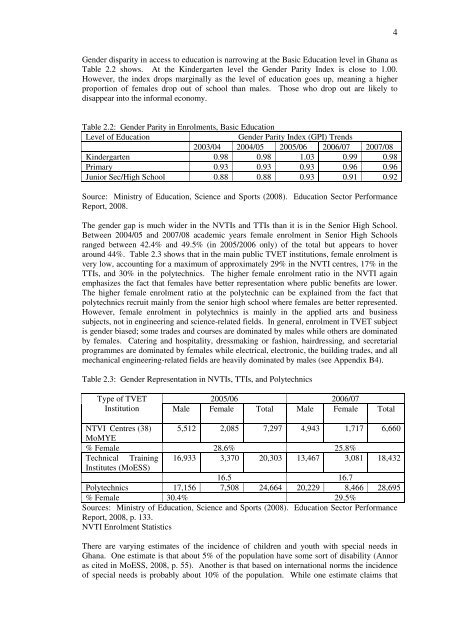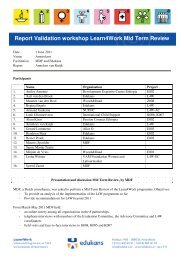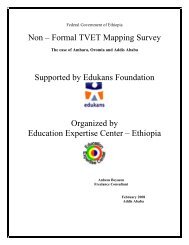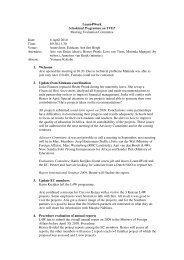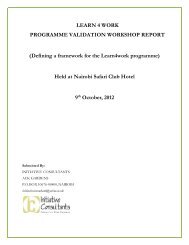DRAFT TECHNICAL AND VOCATIONAL EDUCATION AND ...
DRAFT TECHNICAL AND VOCATIONAL EDUCATION AND ...
DRAFT TECHNICAL AND VOCATIONAL EDUCATION AND ...
Create successful ePaper yourself
Turn your PDF publications into a flip-book with our unique Google optimized e-Paper software.
4<br />
Gender disparity in access to education is narrowing at the Basic Education level in Ghana as<br />
Table 2.2 shows. At the Kindergarten level the Gender Parity Index is close to 1.00.<br />
However, the index drops marginally as the level of education goes up, meaning a higher<br />
proportion of females drop out of school than males. Those who drop out are likely to<br />
disappear into the informal economy.<br />
Table 2.2: Gender Parity in Enrolments, Basic Education<br />
Level of Education<br />
Gender Parity Index (GPI) Trends<br />
2003/04 2004/05 2005/06 2006/07 2007/08<br />
Kindergarten 0.98 0.98 1.03 0.99 0.98<br />
Primary 0.93 0.93 0.93 0.96 0.96<br />
Junior Sec/High School 0.88 0.88 0.93 0.91 0.92<br />
Source: Ministry of Education, Science and Sports (2008). Education Sector Performance<br />
Report, 2008.<br />
The gender gap is much wider in the NVTIs and TTIs than it is in the Senior High School.<br />
Between 2004/05 and 2007/08 academic years female enrolment in Senior High Schools<br />
ranged between 42.4% and 49.5% (in 2005/2006 only) of the total but appears to hover<br />
around 44%. Table 2.3 shows that in the main public TVET institutions, female enrolment is<br />
very low, accounting for a maximum of approximately 29% in the NVTI centres, 17% in the<br />
TTIs, and 30% in the polytechnics. The higher female enrolment ratio in the NVTI again<br />
emphasizes the fact that females have better representation where public benefits are lower.<br />
The higher female enrolment ratio at the polytechnic can be explained from the fact that<br />
polytechnics recruit mainly from the senior high school where females are better represented.<br />
However, female enrolment in polytechnics is mainly in the applied arts and business<br />
subjects, not in engineering and science-related fields. In general, enrolment in TVET subject<br />
is gender biased; some trades and courses are dominated by males while others are dominated<br />
by females. Catering and hospitality, dressmaking or fashion, hairdressing, and secretarial<br />
programmes are dominated by females while electrical, electronic, the building trades, and all<br />
mechanical engineering-related fields are heavily dominated by males (see Appendix B4).<br />
Table 2.3: Gender Representation in NVTIs, TTIs, and Polytechnics<br />
Type of TVET<br />
2005/06 2006/07<br />
Institution Male Female Total Male Female Total<br />
NTVI Centres (38) 5,512 2,085 7,297 4,943 1,717 6,660<br />
MoMYE<br />
% Female 28.6% 25.8%<br />
Technical Training 16,933 3,370 20,303 13,467 3,081 18,432<br />
Institutes (MoESS)<br />
16.5 16.7<br />
Polytechnics 17,156 7,508 24,664 20,229 8,466 28,695<br />
% Female 30.4% 29.5%<br />
Sources: Ministry of Education, Science and Sports (2008). Education Sector Performance<br />
Report, 2008, p. 133.<br />
NVTI Enrolment Statistics<br />
There are varying estimates of the incidence of children and youth with special needs in<br />
Ghana. One estimate is that about 5% of the population have some sort of disability (Annor<br />
as cited in MoESS, 2008, p. 55). Another is that based on international norms the incidence<br />
of special needs is probably about 10% of the population. While one estimate claims that


